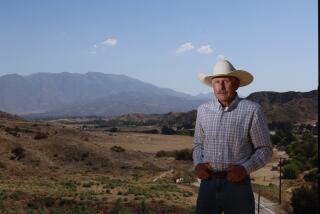Back off, Bambi
Bishop, Calif. — A developer’s plan to bulldoze critical wildlife habitat and build dozens of homes in the Eastern Sierra has run into opposition from scientists, environmentalists, hunters and many local residents who say it will harm beleaguered herds of deer and bighorn sheep.
Travelers along U.S. 395 can see big bucks, does and yearlings in Round Valley during winter, when deer migrate from the Sierra and congregate in lowland brush framed by snowy peaks 10 miles north of Bishop.
This is where Pacifica Development Inc. of Ontario plans to build 189 housing units, including many apartments and duplexes, on 280 acres. The project would provide needed housing but eliminate the historical mining hamlet of Rovana and nearly triple the population in Round Valley.
Pacifica President Jeff Francis says he reduced the project to accommodate wildlife. He says animals and people in the mining community have coexisted for decades. “It should be approved because we’ve made the changes people feel were necessary and addressed all the issues,” he says.
But outstanding questions dog the proposal. Last month, angry residents at a public hearing persuaded the Inyo County planning commission to postpone a decision on the project. Another hearing is scheduled for June 23, and opponents say they will try to defeat it.
Among their questions is whether Linda Arcularius would profit from the project. She serves on the board of supervisors, which has final say over the project, and her family ranch, adjacent to the proposed development, could increase in value if it is approved. Arcularius declined to comment.
The state Department of Fish and Game says that the development would destroy deer habitat and that cars, noise and dogs would frighten wildlife. An environmental impact report warns of “significant, unavoidable” injury to deer.
“[It’s] smack in the middle of critical deer habitat,” says state biologist Vern Bleich.
The Round Valley mule deer herd has declined 60%, to 2,400 animals, in two decades because of drought, fires and development that destroyed bitterbrush. The plant is a key winter food source for deer and is plentiful in Round Valley -- the herd’s only remaining winter range.
Hunters are planting more bitterbrush, but they say more homes in Round Valley will result in fewer hunting opportunities. Rich Day of the Reno-based Mule Deer Foundation says the project is emblematic of habitat-chewing development occurring across the West.
Bighorn sheep, scientists say, probably would be harmed too. The proposed development is near critical forage along Pine Creek that ewes need to birth lambs. Human activity could spook sheep, leading to a smaller herd. Sheep also fall prey to mountain lions if fewer deer are available. The Wheeler Ridge herd consists of about 85 bighorns, and government wildlife biologists say it is critical to the recovery of Sierra Nevada bighorns, an endangered species.
“It’s dangerously close to a major population of bighorn sheep that has a very narrow band of winter habitat,” said John Wehausen, a scientist at the University of California’s White Mountain Research Station. “They’ve tried to say that’s a fair distance, but they’re not willing to project how many people will recreate up there or how many will take dogs.”
Francis says too much is being made of the addition of residents to Round Valley.
“People lose sight of the fact that this was once a vibrant community much larger than it is now,” he says. “We’re not looking at that many more people here. The deer did fine then, and they’ll continue to do fine.”
But Wilma Wheeler of the local Sierra Club chapter says the project is incompatible with the wild and rugged nature of the Eastern Sierra.
“It is a leapfrog development from Bishop,” Wheeler says. “It’s such a beautiful area. It would be a shame if sprawl development ruined it.”
More to Read
Sign up for Essential California
The most important California stories and recommendations in your inbox every morning.
You may occasionally receive promotional content from the Los Angeles Times.









